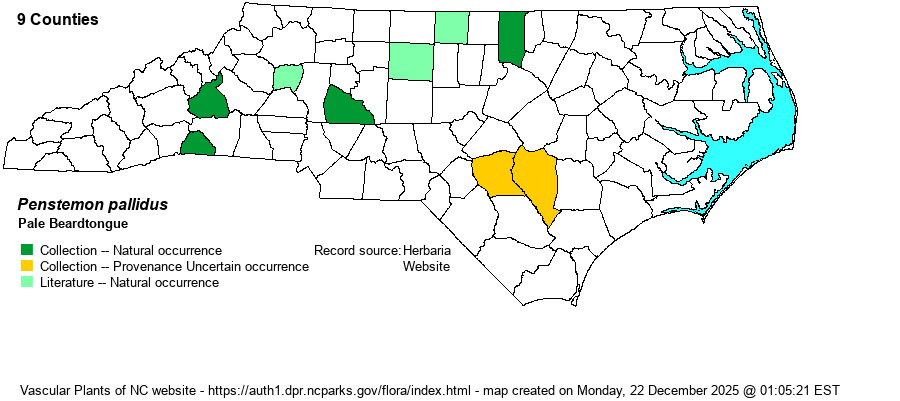| Author | Small | |
| Distribution | A few widely scattered records for the Piedmont and possibly the Mountains close to the Blue Ridge Escarpment. There seems to be some confusion in references, if not also in herbaria, between this species and another species with a very similar distribution -- P. digitalis, both of which range mainly to the north and west of NC and thus records of each in NC must be reviewed for not only accuracy but for provenance. There are a handful of photos reported on iNaturalist, with a few seemingly correct (Research Grade).
This is a mainly Ohio Valley/Midwestern species, though it ranges far northeast into New England. It ranges mainly south to southern VA, and to southern AL. NC has only a few records, some of which might not be natural. The website editors feel that records from the Coastal Plain be considered of uncertain provenance, even though Weakley's (2024) map shows the species as native in all three of NC's provinces. | |
| Abundance | Very rare and poorly known in the Piedmont, collections or USDA records from only four counties. Seemingly absent from the Mountains, though as it is a Midwestern species, the lack of records there is puzzling. This species is now given a Watch List status in 2024. | |
| Habitat | This is a species of dry to somewhat mesic open woods, glades, and fields, probably mainly over high pH soils -- though soil pH affinity is not certain in NC. More information on NC habitats is badly needed. | |
| Phenology | Blooms from May to June, and fruits shortly after blooming. | |
| Identification | This is a typical Penstemon in overall appearance, growing in an erect and unbranched manner to about 2 feet tall. It is clearly pubescent over most of the stem, especially in the upper portions and into the inflorescence; the other two pale-flowered members of the genus, the native P. laevigatus and the uncertain-if-native P. digitalis, are essentially smooth on the stem. P. pallidus has rather narrow lanceolate leaves that are paired (opposite) along the stem; each leaf is pubescent and somewhat thick, about 2-4 inches long and about 1/4 as wide near the base, which is rounded and clasping the stem. The inflorescence at the top of the stem contains a dozen or more narrowly tubular white flowers, only about 4/5-inch long, with the lower corolla lobes extending well forward of the upper lobes; the throat of the flower has purple lines. In addition, the floral tube is scarcely inflated and thus the flowers look "skinny". There are few bracts within the inflorescence. Thus, in summary, this species should be readily identified by the quite hairy (and glandular) stem, even into the inflorescence, and the essentially white and narrowly tubular flowers. Any white-flowered beardtongue is worth collecting or photographing, as the two of them -- P. pallidus and P. digitalis -- are both confused in the state and both need more elucidation regarding range and abundance. NOTE: The common P. laevigatus is almost always a pale pink in color, but where white-flowered, it has a smooth stem and a strongly inflated corolla. | |
| Taxonomic Comments | Though neither this species nor P. digitalis has had taxonomic issues, these two are confused in some references -- especially as to which are native in what state or region, even though both are native in North America.
| |
| Other Common Name(s) | Eastern White Beardtongue | |
| State Rank | S1? | |
| Global Rank | G5 | |
| State Status | W7 | |
| US Status | | |
| USACE-agcp | FACU link |
| USACE-emp | FACU link |

